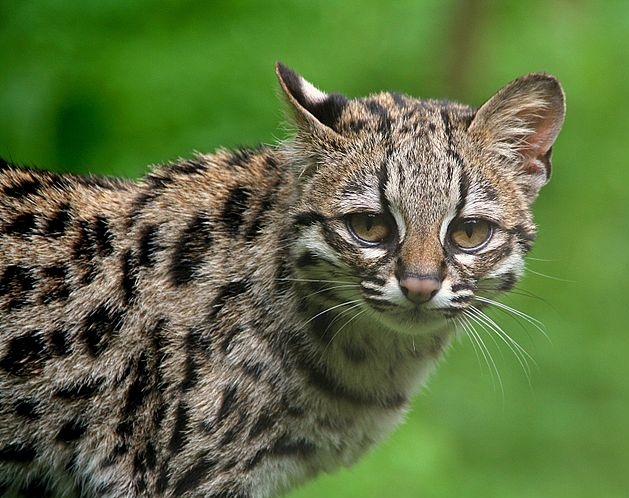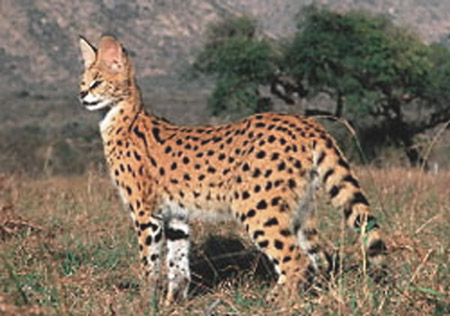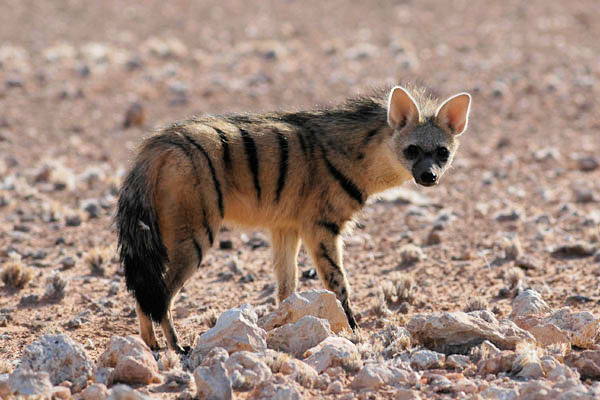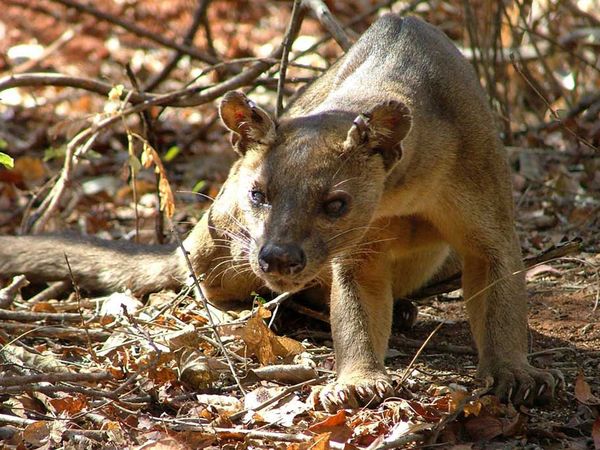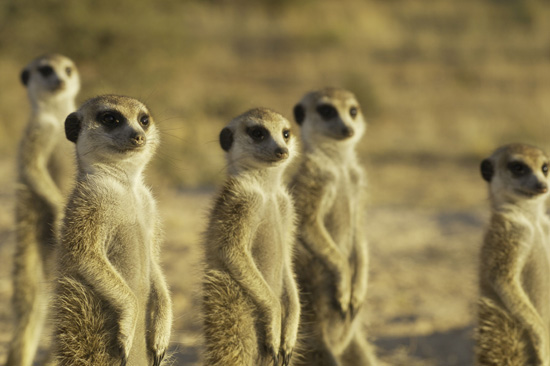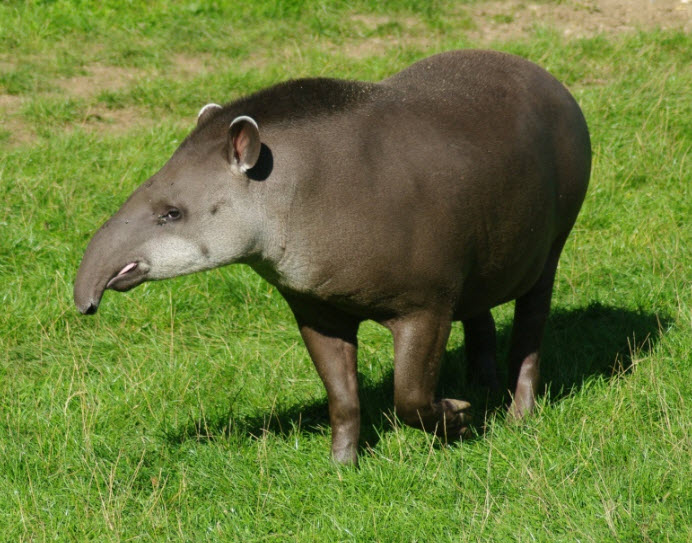Difference between revisions of "Physical World/Mammals - 3"
(Created page with "{| class="wikitable" | |'''Caracal''' ''Caracal caracal'' Sometimes called the desert lynx or African lynx, but it is not a member of the ''Lynx'' genus The most dis...") |
(Added images) |
||
| Line 1: | Line 1: | ||
{| class="wikitable" | {| class="wikitable" | ||
| − | | | + | |[[File:Caracal.jpg|none|thumb]] |
|'''Caracal''' | |'''Caracal''' | ||
''Caracal caracal'' | ''Caracal caracal'' | ||
| + | |||
Sometimes called the desert lynx or African lynx, but it is not a member of the ''Lynx'' genus | Sometimes called the desert lynx or African lynx, but it is not a member of the ''Lynx'' genus | ||
| − | |||
The most distinctive feature of the caracal is the long black tufts on the back of the ears | The most distinctive feature of the caracal is the long black tufts on the back of the ears | ||
|- | |- | ||
| − | | | + | |[[File:Bobcat.jpg|none|thumb]] |
|'''Bobcat''' | |'''Bobcat''' | ||
''Lynx rufus'' | ''Lynx rufus'' | ||
| + | |||
Ranges from southern Canada to central Mexico | Ranges from southern Canada to central Mexico | ||
| − | |||
It has distinctive black bars on its forelegs and a black-tipped, stubby tail, from which it derives its name | It has distinctive black bars on its forelegs and a black-tipped, stubby tail, from which it derives its name | ||
|- | |- | ||
| − | | | + | |[[File:Ocelot.jpg|none|thumb]] |
|'''Ocelot''' | |'''Ocelot''' | ||
''Leopardus pardalis'' | ''Leopardus pardalis'' | ||
| + | |||
Also known as the dwarf leopard | Also known as the dwarf leopard | ||
| − | |||
Distributed extensively within South America | Distributed extensively within South America | ||
| − | |||
Similar in appearance to a domestic cat. Its fur resembles that of a clouded leopard or jaguar | Similar in appearance to a domestic cat. Its fur resembles that of a clouded leopard or jaguar | ||
|- | |- | ||
| − | | | + | |[[File:Margay.jpg|none|thumb]] |
|'''Margay''' | |'''Margay''' | ||
''Leopardus wiedii'' | ''Leopardus wiedii'' | ||
| + | |||
Also known as the tree ocelot | Also known as the tree ocelot | ||
| − | |||
Similar to the larger ocelot in appearance, although the head is a little shorter, the eyes larger, and the tail and legs longer | Similar to the larger ocelot in appearance, although the head is a little shorter, the eyes larger, and the tail and legs longer | ||
|- | |- | ||
| − | | | + | |[[File:Serval.jpg|none|thumb]] |
|'''Serval''' | |'''Serval''' | ||
''Leptailurus serval'' | ''Leptailurus serval'' | ||
| + | |||
A medium-sized African wild cat native to sub-Saharan Africa | A medium-sized African wild cat native to sub-Saharan Africa | ||
| − | |||
Servals have the longest legs of any cat, relative to their body size | Servals have the longest legs of any cat, relative to their body size | ||
|- | |- | ||
| − | | | + | |[[File:Aardwolf.jpg|none|thumb]] |
|'''Aardwolf''' | |'''Aardwolf''' | ||
''Proteles cristata'' | ''Proteles cristata'' | ||
| + | |||
A small, insectivorous hyena-like mammal, native to Eastern and Southern Africa | A small, insectivorous hyena-like mammal, native to Eastern and Southern Africa | ||
| − | |||
Second animal in the dictionary, after aardvark | Second animal in the dictionary, after aardvark | ||
|- | |- | ||
| − | | | + | |[[File:Fossa.jpg|none|thumb]] |
|'''Fossa''' | |'''Fossa''' | ||
''Cryptoprocta ferox'' | ''Cryptoprocta ferox'' | ||
| + | |||
A cat-like, carnivorous mammal endemic to Madagascar. Resembles a small cougar | A cat-like, carnivorous mammal endemic to Madagascar. Resembles a small cougar | ||
| − | |||
The largest mammalian carnivore on the island of Madagascar | The largest mammalian carnivore on the island of Madagascar | ||
| Line 83: | Line 82: | ||
|- | |- | ||
| − | | | + | |[[File:Meerkat.jpg|none|thumb]] |
|'''Meerkat''' | |'''Meerkat''' | ||
''Suricata suricatta'' | ''Suricata suricatta'' | ||
| + | |||
Meerkats are members of the mongoose family native to Botswana, Namibia, and South Africa | Meerkats are members of the mongoose family native to Botswana, Namibia, and South Africa | ||
| − | |||
Meerkats forage in a group with one "sentry" on guard watching for predators while the others search for food and "Compare The Market” | Meerkats forage in a group with one "sentry" on guard watching for predators while the others search for food and "Compare The Market” | ||
|- | |- | ||
| − | | | + | |[[File:Tapir.jpg|none|thumb]] |
|'''Tapir''' | |'''Tapir''' | ||
| Line 100: | Line 99: | ||
genus ''Tapirus'' | genus ''Tapirus'' | ||
| − | |||
| + | Brazilian, Malayan, Mountain, Baird's – species of tapir | ||
Tapirs inhabit jungle and forest regions of South America, Central America, and Southeastern Asia | Tapirs inhabit jungle and forest regions of South America, Central America, and Southeastern Asia | ||
Revision as of 14:20, 5 July 2021
| Caracal
The most distinctive feature of the caracal is the long black tufts on the back of the ears | |
| Bobcat
It has distinctive black bars on its forelegs and a black-tipped, stubby tail, from which it derives its name | |
| Ocelot
Distributed extensively within South America Similar in appearance to a domestic cat. Its fur resembles that of a clouded leopard or jaguar | |
| Margay
Similar to the larger ocelot in appearance, although the head is a little shorter, the eyes larger, and the tail and legs longer | |
| Serval
A medium-sized African wild cat native to sub-Saharan Africa Servals have the longest legs of any cat, relative to their body size | |
| Aardwolf
Second animal in the dictionary, after aardvark | |
| Fossa
The largest mammalian carnivore on the island of Madagascar
| |
| Meerkat
Meerkats forage in a group with one "sentry" on guard watching for predators while the others search for food and "Compare The Market” | |
| Tapir
Tapirs inhabit jungle and forest regions of South America, Central America, and Southeastern Asia | |
| Przewalski's Horse
| |
| Onager
Also known as hemione or Asiatic wild ass
| |
| Peccary
| |
| Chevrotain
| |
| Pudu
| |
| Muntjac
Also known as barking deer
| |
| Père David's deer
Native to the subtropics of China
| |
| Pronghorn
Though not an antelope, it is often known colloquially in North America as the prong buck or pronghorn antelope
| |
| Gaur
| |
| Muskox
Arctic mammal of the family Bovidae noted for its thick coat and for the strong odour emitted during the seasonal rut by males, from which its name derives | |
| Chamois
| |
| Nilgai
Largest Asian antelope
| |
| Bongo
Large African forest antelope
| |
| Grey rhebok
Antelope endemic to Southern Africa
| |
| Wildebeest
| |
| Klipspringer
| |
| Giraffe
Tallest living terrestrial animal and the largest ruminant
| |
| Okapi
The okapi and the giraffe are the only living members of the family Giraffidae
| |
| Alpaca
A domesticated species of South American camelid. It resembles a small llama in appearance
| |
| Vicuna
Believed to be the wild ancestor of domesticated alpacas
| |
| Guanaco
Native to the arid, mountainous regions of South America
| |
| Blue whale
At 30 metres in length and 180 tonnes in weight, it is the largest extant animal and is the heaviest known to have existed
| |
| Bowhead whale
Also known as the Greenland right whale or Arctic whale
| |
| Narwhal
Toothed whale that possesses a large "tusk" from a protruding canine tooth. Narwhal tusks were believed to be the horns from the legendary unicorn
| |
| Beluga whale
Also known as white whale, or sea canary due to its high-pitched twitter
| |
| Sperm whale
Also known as cachelot
The head of the whale contains a liquid wax called spermaceti, from which the whale derives its name | |
| Killer whale
Also known as orca, blackfish, or grampus
| |
| Vacuita
A rare species of porpoise endemic to the Gulf of California. Smallest cetacean
| |
| Elephant seal
Two species – northern and southern
| |
| Dugong
Dugong, together with the manatees, is one of four living species of the order Sirenia
| |
| Manatee
Also known as sea cows
|



